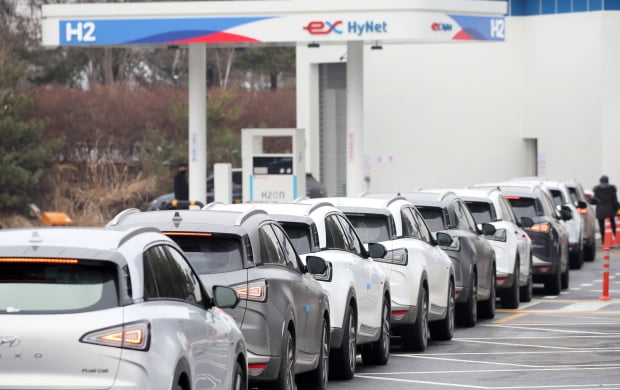
On the 21st, there are long lines of vehicles waiting for charging in front of the hydrogen charging station, which started pilot operation in the Chuncheon Service Area on the Jungang Expressway in Chuncheon City, Gangwon-do. Photo = Yonhap News
# “Have you been to a hydrogen charging station? The standby time only takes over an hour to charge once. I would rather ride (hydrogen car) because it’s so uncomfortable.”
Lee Mo, 32, an office worker who shared his acquaintance’s experience in charging hydrogen vehicles, pointed out the poor reality of the hydrogen vehicle charging infrastructure and said this. He shook his head, “I heard that people living in Gangwon-do are coming to the metropolitan area to charge them.”
There are more and more hydrogen cars going around the road, but the construction of charging stations is delayed, and the inconvenience Lee pointed out is not being resolved. The government has made plans to supply 15,000 hydrogen cars this year, but the infrastructure is insufficient. As a result, some point out that charging difficulties may increase in the industry.

Hyundai Motor Company’s hydrogen car Nexo is waiting in line to charge at the’H Gang-dong Hydrogen Charging Station’ in Gangdong-gu, Seoul operated by GS Caltex. Photo = Korea Economic Daily DB
According to the industry on the 22nd, the Ministry of Trade, Industry and Energy, the Ministry of Strategy and Finance, and the Ministry of Environment presented 15,185 units of this year’s hydrogen vehicle supply target through the ‘2021 Subsidy System Reorganization Plan’ on the previous day, a 49.2% increase from the previous year. To this end, the government budget increased from 239.3 billion won to 3655 billion won, and subsidies have also been greatly increased.
The government subsidy for hydrogen cars is 22.5 million won. Subsidies for each local government range from 9 million to 15 million won. Gangwon-do, which has the largest local government subsidies, can receive up to 37.5 million won in total, and 11 million won in Seoul is subsidized for a total of 33.5 million won.
This is a factor that raises the cost/performance ratio (price/performance) of Hyundai Nexo, the only hydrogen car in Korea. This is because if you receive the maximum subsidy support for Nexo, which costs 67.6 million won, you can purchase it for 3,150,000 won.
Although it is cheaper than a car with an internal combustion engine of the same class, the charging time is shorter and the mileage is longer than that of electric cars, so sales of hydrogen cars are steadily increasing. In addition, various benefits such as reduction in automobile tax and half of highway tolls are added.
The number of hydrogen vehicles registered by the Ministry of Land, Infrastructure and Transport soared from 893 at the end of 2018 to 10,906 at the end of last year. It jumped more than 10 times in two years. By region, there are 1671 units in Seoul, 1578 units in Gyeonggi, 1819 units in Ulsan, and 916 units in Busan.

A hydrogen charging station near the Sky Garden of Incheon International Airport Terminal 1, which started operation on the 4th. Photo = News 1
However, there are only 44 charging stations nationwide. By the way, the number will be reduced to 40 except for charging stations that have been shut down due to failure. It is calculated that one charging station has to handle 272 units on average. According to the Ministry of Environment, in the case of Seoul, there are currently only three charging stations available, so even if you calculate simply, 557 vehicles will be concentrated in one charging station.
Although it is shorter than an electric car, the charging time is longer than that of a general internal combustion engine, which adds to this problem. It usually takes about 5 minutes to charge one hydrogen car. However, it is impossible to charge continuously like a gas station. After charging one, it is necessary to increase the pressure of the hydrogen tank for at least 10 minutes and then charge it again for 5 minutes. Five minutes is enough to charge one, but it takes 20-30 minutes to charge two, and about 50 minutes or more to charge three.
The government plans to build 54 hydrogen refueling stations this year, but the possibility of realization is questionable. The government set a goal to install 100 charging stations last year, but it has lowered the target to 72 units due to the burden of securing a site and building costs of over 3 billion won per unit.
The fact that there are many local residents who question the safety of hydrogen charging stations is another factor that makes it difficult to expand charging stations. In the case of the Yangjae charging station in Seoul, which is scheduled to open after finishing the facility’s modernization this year, some local residents raised the possibility of an explosion and strongly opposed the reopening.
An industry insider pointed out, “In fact, it is unclear whether the charging station can be built as much as the target value,” and pointed out that “every time, we have to come up with a realistic plan instead of putting an ineffective target as a countermeasure.”
Shin Hyun-ah, reporter at Hankyung.com [email protected]
Article reports and press releases [email protected]
